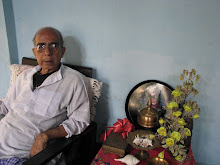FROM THE NOTE BOOK (4)
There are so many allusions about prisons, arrests etc. that it may naturally lead to some questions: where, why etc. Briefly, I was a political prisoner in East Pakistan (the then) for being a member of the communist party of East Pakistan, which almost always was a banned organization there. During the period lasting from 1949 to early 1956 I was thrice imprisoned for a total duration of six years one month. This explanation, I hope, will remove most of the confusions.
Today is 24th April. On this day in 1950 prison guards aided by hardened criminal convicts fired upon us, severely assaulted us leading to death of seven inmates and grievously injuring almost all of the thirty nine prisoners inside the ward. Two or three decades ago memorial meetings were held in Kolkata and elsewhere in honour of those who sacrificed their lives in this brutal killing. Gradually, with the disappearance of people of those days, waning of memory and crowding in of scores of more tragic events these memorial assemblies are naturally on the way out.
Leaving aside the post 2nd world war politics prevalent at that time developments inside Rajshahi Central Jail would be an interesting study. At the other end of the spectrum Burmese communists, particularly the white flag were waging a terrible war of insurgency against the alliance led by Aung San. Indonesian communists led by Aidet and egged on by Chinese communists were fighting the then Indonesian military led regime of Suharto ending ultimately in a horrible disaster for Indonesia. Indo China (present day Vietnam) were fighting French America combine and winning dramatically. In this backdrop of ferment powerful sections of Indian communist movement decided that an armed struggle could be waged against big bourgeois landlord collaborators backed by Anglo American imperialism and could be won decisively. By hind sight you can today describe this as infantile impulse but this kind of thinking definitely influenced us. We thought that if the prisoners could be made to rebel and a massive jail break could be staged there would be an explosive situation .Beyond that we did not want to think. To this end we set to work.
We started organizing. We established excellent contacts with greater sections of prisoners and undertrials. Total population inside the jail had been definitely more than two thousand five hundred .Our ward committee, or rather the jail committee used to publish regularly every week a neat and beautiful handwritten manuscript magazine Mazdoor . On this occasion a special issue of Mazdoor with several copies was published. Front page screamer’s free English translation would be something like” stand up in anger like Yusuf Beg” (Yusuf Beger Moto Rukhe Daraon). After recounting the heroic sacrifice of Yusuf Beg a demand for the thorough reform of jail manual was raised. Yusuf was a convict serving life imprisonment, who attacked and killed the English superintendent of the jail during Sunday routine inspection parade. Yusuf Beg had many serious grievances which were ignored and he was regularly harassed and abused. Yusuf was tried and executed.
The memorandum of demand s were mainly drawn up ,prepared and circulated by us. Apart from many demands for the improvement of living condition, food, clothing etc the vital demand of paying wage to the convicts serving rigorous imprisonment made the authorities see red. Those who have a little idea of a large prison should be well aware of large departments of cane crafts, tailoring shop, handloom,powerloom, leather craft, smithy, press, and many others,- an impressive assortment of small scale industries run by the labour of convicts . Till twenty five years or so ago even in independent India British sponsored jail manual was followed. According to this manual no wages were paid to the convict labour and they were never allowed to buy their small needs like tobacco etc from their personal cash lying in the jail office. Prisoners placed these demands and resorted to en masse indefinite food refusal. In the evening whole prison used to roar with slogans raised by the prisoners. This was certainly unprecedented. The line of administration from Dhaka to Rajshahi central jail was aflame with anger and anxiety. This was a situation termed as mutiny in the jail manual. A clash with some political prisoners leading to firing and deaths is relatively a tame thing compared to this highly volatile situation. Cases of clashes between political prisoners and guards had happened in the past but a largescale mutiny of the prisoners left the the authorities in a desperate state. The prison authorities finally capitulated and promised to look into the grievances of general prisoners. The mutiny of the prisoners was naturally over because the authorities had conceded to favourably consider their demands. Prisoners in general were not interested in a foggy idea about a revolution.
At this point prison authorities and the government in Dhaka planned to teach us a lesson. They decided to disperse us in smaller groups in to segregated enclosure. Supposedly dreaded ones to be confined to fourteen cells. They were aware that clashes would take place and a bloodbath was in their plans. It was 1950 and both Bengals were swept by the second biggest communal carnage. Looking back some of us till this day wonder in such a situation how could we organize a prison mutiny of such a dimension. Those were the days of such communal frenzy that a state frankly established on the basis of religious communalism verging on a fundamentalist attitude could rather decide to wipe out this small group of communists and left wing elements, seventy per cent of whom in the religious sense had a Hindu background They thought but failed to start a prisoners’ riot of a communal nature. Instead in the hot morning of 24th April authorities staged a blood bath in the Khapra ward when the political prisoners were just getting ready for their breakfast of chapatis, vegetables and tea.
The word Khapra in North Bengal dialect means red tiles. Khapra ward was a red tile roofed bungalow looking prison ward meant for accommodating defaulting landlords held under Bengal regulation III of late nineteenth century. These prisoners were rajahs and maharajahs and the lavish expenditure after them was borne by the government. It was quite a beautiful building with barred French windows numbering around ten or twelve. Khapra ward had another name Diwani because prisoners of Diwani (land revenue related) cases were held there. Surrounding was spacious with half a dozen impressive looking Neem trees and a very big well full of clear, cold and wholesome water. It was difficult to imagine that on this sunny hot morning there would be murders in this beautiful place. At worst we bargained for a tough physical conflict but never a shooting of buck shots from bolt action rifled muskets at practically point blank range because there never was a need of such a firing upon unarmed prisoners inside a barrack and that too without any warning. Mr. Bill,the jail superindeant, a huge anglo indian extremely enthusiastcally led the whole operation. Our plan was if the authorities applied force we would capture the officers and force them inside the barrack.Mr. Bill could manage to escape but two deputy jailors were catured by us and they were also injured in the ensuing indiscriminate firing.
Rest is history. Seven killed and every one injured, some very seriously. A few were crippled for whole life. Buck shots or riot cartridges as called by British soldiery fired from a long distance result in lighter wounds. Fired from close range they create ugly and fatal wounds. Yes, we were fearless. This fearlessness demands rich tribute. But it should be remembered that fearlessness alone is not the only capital with which revolutionary battles are fought. As for infantile impulses probably none of us is immune to it. Nobody is born old. Infantilism and mature behaviour they all join together to create the wonderful thing that is called stream of life.
Camera footage: Hindutva demo in Britain
-
https://twitter.com/HindutvaWatchIn/status/1781134993718137192
20 hours ago






